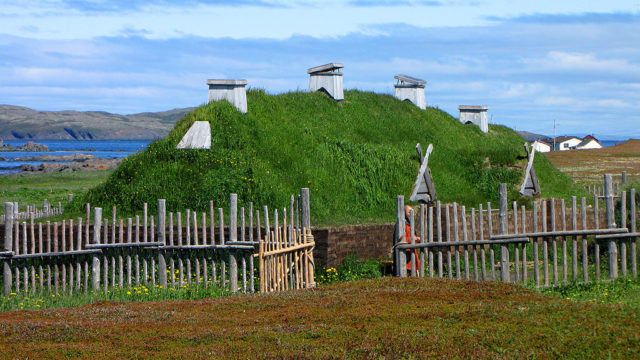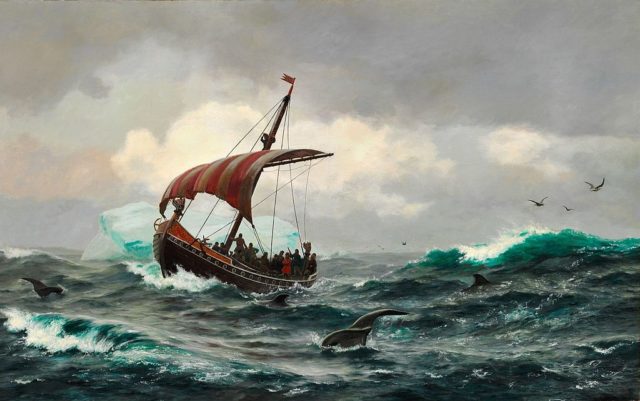Is there proof of the Scandinavian Vikings landing in North America?
L’Anse aux Meadows, an unsuccessful Norse settlement of Viking adventurers from Iceland that was inhabited for somewhere between three and ten years, is an archaeological dig that is located in the province of Newfoundland in Canada.

Near the beginning of the nineteenth century, a Canadian historian pored over medieval Icelandic manuscripts and documents portraying the adventures of the tenth century Vikings. Two of them, ‘Erik’s Saga’ and ‘the Greenlander Saga’ described the journeys and adventures of Erik the Red (correct spelling Eirik), Leif Erikson, and Thorvald Arvaldson, three generations of a rather bad-tempered family of Norse seafarers.

The manuscripts reported that Thorvald fled Norway because of a murder charge and eventually put down roots in Iceland. His son Eirik, facing a similar charge, fled Iceland and settled in Greenland, and Eirik’s son Leif (the Lucky), took his family even further westward and around 998 AD he colonized a land he called ‘Vinland,’ – in the Old Norse language it meant ‘land of grapes.’
Leif’s settlement stayed at Vinland between three and ten years, before they were forced to leave because of continuous attacks from the residents, whom the Vikings called Skraelings. Most historians believed that the most probable location for the settlement was on the island of Newfoundland, using the argument that ‘Vinland’ did not signify grapes, but rather suggested grass or grazing land since grapes didn’t grow in Newfoundland.

Helge Ingstad, an accomplished explorer from Norway, and his archaeologist wife Anne Stine Ingstad, embarked on a survey close to the shorelines of Newfoundland and Labrador in the early 1960s. Ingstad, a Norwegian explorer, had spent the greater part of his career investigating Northern and Arctic civilizations and was continuing with research into the Viking expeditions of the tenth and eleventh centuries. In 1961, the survey was rewarded, and the Ingstads discovered an undeniably Viking commune near Epave Bay and called the site Jellyfish Cove, as indicated by the stinging jellyfish found in the bay, or what it is known as today – L’Anse aux Meadows.
Artifacts unearthed from L’Anse aux Meadows numbered in the hundreds and included an eleventh-century Norse carved spindle whorl made from soapstone and a bronze-ringed pin, as well as many other bones, bronze, stone, and iron items. Radiocarbon dates placed the inhabitants at the site between approximately 990 and 1030 AD.
L’Anse aux Meadows was not a typical Norsemen village. The location was comprised of three building facilities and a bloomery furnace, but no barns or stables that would be linked with farming. Two of the three facilities consisted of a longhouse and a small hut; the third, added a small house to complete the complex. It appears that the privileged resided at one end of the longhouse, the regular oarsmen slept in the sleeping areas within the halls, and servants, or, more probable, slaves, stayed in the hut.
The buildings were built in the Icelandic design, with heavy sod rooftops supported by central pillars. The bloomery smelter was a simple iron smelting furnace within a small underground shack and a charcoal kiln pit. The large buildings were the primary community areas that contained sleeping areas, kitchen, sitting room, storage area, and a carpentry workshop.
L’Anse aux Meadows accommodated from 80 to 100 people, probably close to three ship crews. All of the buildings were occupied at the same time, About Education reported.

L’Anse aux Meadows is now maintained by Parks Canada, who performed excavations at the site during the mid-1970s. Based on the restorations undertaken by Parks Canada at the site, a total of 86 trees were cut down for furnishings, roofs, and posts; 1,500 cubic feet of sod was utilized for the roofs.
The archaeological dig was declared a UNESCO World Heritage site in 1978, and Parks Canada has maintained the reconstruction as a ‘living history’ museum, complete with uniformed interpreters and guides.
